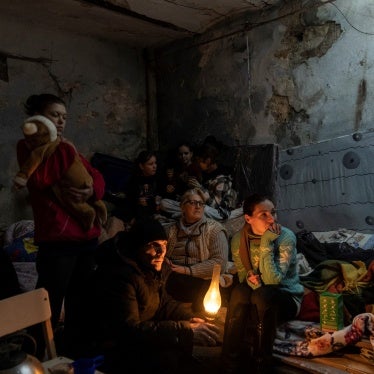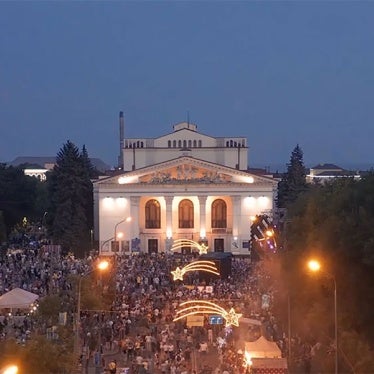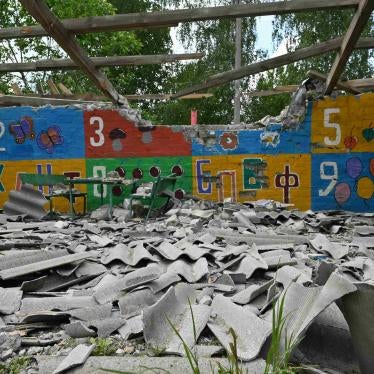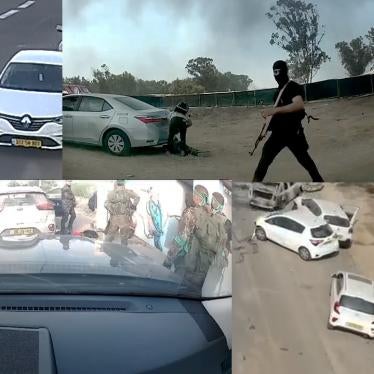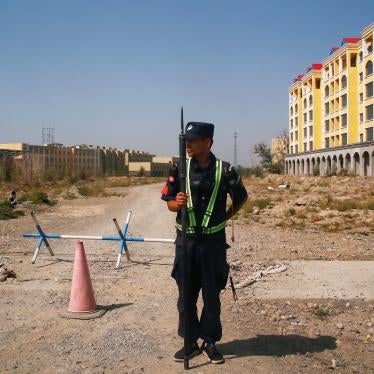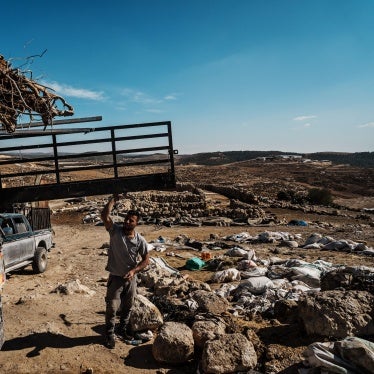- 俄羅斯2022年進攻烏克蘭馬里烏波爾市,導致成千上萬平民死傷,最新調查顯示其中包含許多疑似非法攻擊行為。
- 俄羅斯軍隊摧毀馬里烏波爾並持續致力抺殺烏克蘭文化,堪稱俄軍全面入侵烏克蘭的最醜惡篇章之一。
- 致力尋求正義的國際機構和各國政府應集中力量調查可能涉及馬里烏波爾戰爭罪行的俄羅斯高級官員。
(基輔)-人權觀察、真相追蹤(Truth Hounds)和現場研究團隊(SITU Research)今天發表含有廣泛新發現的報告指出,俄羅斯軍隊於2022年2月到5月對烏克蘭城市馬里烏波爾(Mariupol)的進攻,包含許多疑似非法攻擊行為,導致成千上萬平民死傷,數十萬人被圍困數週且無法獲得基本服務。俄羅斯總統普京和其他高級官員應當受到調查,並因其在俄軍於當地作戰期間犯下疑似戰爭罪行中的作用而受適當起訴,俄羅斯也應向違反戰爭法行為的受害者及其家屬提供賠償。
這份224頁的報告《「我們的城市灰飛煙滅」:俄羅斯對烏克蘭馬里烏波爾的毀滅攻擊》,以及附帶的數位多媒體專題報導和一段20分鐘影片,分析了當地平民苦難和成千上萬建築物受到的毀損,包含數百棟高層公寓、醫院、教育機構和水、電供應設施。同時,也說明烏克蘭官員和國際機構多次嘗試組織正式撤離和援助物資遞送,均遭俄方阻撓。

閱讀這支影片的文字描述
VAAGN MNATSAKANIAN: “In the first days of the war, we had no idea that such a tragedy could take place.”
TETIANA BURAK: “That’s why a lot of people didn’t evacuate.”
MYKHAILO PURYSHEV, MARIUPOL RESIDENT AND HUMANITARIAN VOLUNTEER: “With the onset of the war, everyone’s life changed. Everything changed.”
VOICE IN VIDEO: “Stay back!”
This is the story of Russia’s assault on Mariupol.
A strategic port city in southeastern Ukraine.
These are the interviews, videos, photos, and 3D models that Human Rights Watch, SITU Research, and Truth Hounds used to reconstruct the struggles residents faced as Russian forces took over the city.
This is Mariupol after Russian forces occupied the city. Russia’s full-scale military invasion of Ukraine began on February 24, 2022, as its forces attacked Ukrainian positions defending Mariupol.
The city was pounded by explosive weapons for weeks.
Much of Mariupol was seriously damaged in the Russian assault. Human Rights Watch and SITU Research conducted a detailed damage assessment of the destruction. While satellite imagery shows damage to rooftops, our modeling reveals more. We used over 850 videos and photos of buildings that we found online and verified, in addition to satellite imagery, to capture the extent of the devastation in the city center. Buildings with damage are seen here in red. Our analysis shows that 93% of the 477 high-rise apartment buildings in this area were damaged. Some of this imagery could help prove war crimes. Our focus was Mariupol’s main avenue, Myru or “Peace” Avenue, and the immediate surrounding area, the city center, which includes cultural hubs, hospitals, schools, and universities.
And this is Mariupol before.
DMYTRO KULYK: “It’s [was] a town with about half a million inhabitants.”
HALYNA MOROKHOVSKA: “Recently, it had blossomed. We had new parks. The city center was well-developed.”
NATALIIA TKACHENKO: “In general, the city was becoming modern and vibrant.
For Russian forces, Mariupol was a strategic prize. It would give them control of one of Ukraine’s largest ports and a land corridor between occupied Crimea to the west and areas Russia had been controlling in Donbas, to the northeast.
As the attack on the city began, tens of thousands of civilians huddled in shelters and basements to escape Russian bombing and shelling. Many people we spoke to relocated to the city center, which they believed to be safe.
DENYS SHEVTSOV: “Most people moved in all directions. To a bomb shelter, to a basement. Some stayed in their apartments. But we believe it isn’t safe to stay in the apartment... We are in the basement now. This is our makeshift bomb shelter. These are the conditions we live in. About 40 people live here with us, about 15 children.”
DENYS SHEVTSOV: “This morning, our yard was heavily shelled. Basically, all the cars were destroyed, and the windows.”
Russian forces used a variety of explosive weapons in Mariupol including aerial bombs and ground-launched artillery, such as projectiles and rockets. The use of these weapons in populated areas is the greatest threat to civilians in contemporary armed conflicts and heightens the risk of unlawfully indiscriminate attacks.
HALYNA MOROKHOVSKA: “An aerial bomb hit the dormitory. My face was torn up. I had cuts everywhere. My arm, chest, stomach, legs.”
VOICE IN VIDEO: “It’s coming from that side.”
VOICE #2 IN VIDEO: Come into the entryway...
DMYTRO KULYK: “Dead bodies became an ordinary sight for me. We were told that seven people died that one day. Two children and five adults.
Under the laws of war, parties have an obligation to do everything feasible to minimize harm to civilians.
These are the maternity and pediatric units of a hospital that Russian forces bombed on March 9.
At least three people were killed, including a pregnant woman and her baby, who was stillborn after the attack. Seventeen people were injured. In this case, witnesses told us that there were no Ukrainian military personnel, vehicles, or installations close by at the time. A deliberate strike on a hospital not being used to carry out attacks harmful to the enemy, is a war crime.
Humanitarian volunteer Mykhailo Puryshev was about 400 meters from the hospital by Pryazovskysi State Technical University.
MYKHAILO PURYSHEV: “Everyone is very, very afraid. Everyone is very afraid. You hear that, don’t you? The rumbling. It’s Mariupol... “
MYKHAILO PURYSHEV: “I heard an airplane approaching… And I shouted “Airplanes!” and we all ran... “
MYKHAILO PURYSHEV: Fucking hell! Go down!
MYKHAILO PURYSHEV: “When I went outside, I saw the full horror of what had happened.”
VOICE IN VIDEO: “Was it a mine?”
MYKHAILO PURYSHEV: “No, an airstrike most likely.”
VOICE IN VIDEO: “Grandma...”
MYKHAILO PURYSHEV: “Drag her, drag her!”
At least two people were killed on the spot. Witnesses said there were no military targets at the university. An attack that is not directed at a specific military objective is a laws-of-war violation and a possible war crime. Numerous images posted on social media and given to us by witnesses helped us assess the damage to parts of the university campus. The fighting damaged vital infrastructure, knocking out the city’s electricity grid, which in turn cut essential services.
DENYS SHEVTSOV: “So, we’re left without gas, without water, without power. We are absolutely isolated from civilization. No internet, no updates. Nothing.”
DMYTRO KULYK: ‘’If you want to wash your hands, this is the only way. So we pick up snow, put it in a bucket. Then we put the bucket on an open fire and boil the water.”
DENYS SHEVTSOV: “Here is our field stove. We live like in the Stone Age in caves. This is what I call really living it up during the war. Bacon, pasta. And shells are flying overhead. As long as they don’t make barbecue out of us.”
DENYS SHEVTSOV: “The city was destroyed. And every day, the city was getting destroyed more and more.”
DMYTRO KULYK: “I am telling you, day after day, these explosions became more frequent. Every day, they got louder and more hellish.”
We used satellite imagery, photos, and videos to track damage across Mariupol. We found 86 out of 89 schools and universities were damaged, and all the city’s 19 hospital campuses. The damage to these facilities devastated health care and education across the city.
VAAGN MNATSAKANIAN: “Every day we thought about when we could leave. But we realized that the city was completely closed off and there was no way to leave.”
In the first two weeks of March, multiple attempts to provide safe passage out of the city failed in the face of Russian obstruction. Arbitrary restrictions on the evacuation of civilians or the delivery of aid would amount to a violation of the laws of war and possible war crimes.
In early March, hundreds of people had gathered at the Donetsk Academic Regional Drama Theater, for shelter and in the hope of getting safe passage out of Mariupol.
Nataliia Tkachenko arrived on March 12 after an attack destroyed her home.
NATALIIA TKACHENKO: “They gave us a bit of food. A soup in the afternoon, a cup of boiled water in the morning and evening. It was something. At home there was no water, no food, nothing. It was dark, there was no electricity. It was impossible to use the toilets. There was no water. Nobody was cleaning them. It was a nightmare. No one was walking around the theater. Only kids were running around because kids will be kids. They were playing and laughing.”
At least 500 people were sheltering at the theater on March 16. Giant Cyrillic letters spelling “children” were painted on the ground in front and at the back of the theater. These words were clearly visible on satellite imagery.
Nataliia was bringing water inside, by the main entrance.
NATALIIA TKACHENKO: “And at that moment, the bomb struck. The shockwave hit us. Everything was flying around. Cement got in my mouth, eyes, everywhere. Shards of wood and glass. I couldn’t hear anything except the humming, the cracking.”
Satellite imagery, videos, and photographs of the theater show that the central part of the roof and the northern and southern walls were destroyed. At least 15 people were killed and the total number has not been determined. Given the absence of a military target at the theater, it appears that Russian forces deliberately attacked civilians, which would amount to a war crime.
Those responsible for war crimes in Mariupol should be held to account. By reviewing official Russian government statements, social media posts, and obituaries of Russian soldiers, we identified 17 military units that took part in the 2022 siege of Mariupol.
Considering the extent of the military operation, the highest levels of Russian command likely knew the situation in the city and were involved in the planning, execution, and coordination of the actions of the Russian and Russia-affiliated forces.
Those responsible for the conduct of Russian forces during the siege of Mariupol include President Vladimir Putin, the Commander-in-Chief of the Armed Forces, Minister of Defense Sergei Shoigu, and Chief of the General Staff of the Armed Forces, Valery Gerasimov, among others.
As the battle for the city raged, food and other basic supplies ran low.
VOICE IN VIDEO: Wait. Step back a little.
MIKHAILO PURYSHEV: You may crush others! Please!
MIKHAILO PURYSHEV: “The worst problem was probably not with food or heat, but with medication. And people were just dying because there was none. The people who suffered the most were older people and children.”
Thousands were killed in attacks. Others died from health complications due to lack of medicine and clean water.
MIKHAILO PURYSHEV: “Mariupol is a big, big, big, big cemetery. There were a lot of people left under the rubble. So it remains to be seen how many people died there.”
TETIANA BURAK: “We were horrified at what we saw because there were burnt multi-story houses and bodies in the streets.”
HALYNA MOROKHOVSKA: “It was impossible to count them because people were buried under the debris, on the roads.”
Many were buried in a makeshift trench grave in the Old City Cemetery.
VAAGN MNATSAKANIAN: “We filled one trench [with bodies] completely. There were about 200 bodies.”
These bodies from the trench grave and many other makeshift graves across the city were exhumed and reburied in the city's cemeteries when Russian forces took over. We estimated the minimum number of people killed by fighting or who died of poor conditions. To do so, we counted graves in two types of burial sites. In some cases, we counted individual graves visible in high resolution satellite imagery. We also estimated the number of bodies buried in trench-type graves. We verified footage at two cemeteries which allowed us to count the plaques, sticks with a small wooden panel, in a given area. We then used this sample size to extrapolate to other parts of the cemeteries. In five cemeteries in and around Mariupol between March 2022 and February 2023, we estimated at least 10,284 new burials.
We do not know how many of these people were civilians. Considering average annual death rates in Mariupol, we calculated more than 8,000 people would not have died were it not for the attack on the city. This is likely a significant underestimation of the total number of dead, as many graves contained multiple bodies and the remains of others were likely buried in the rubble and taken away during demolition efforts.
With the city still under Russian occupation and much of the physical evidence destroyed, the full death toll may never be known.
DENYS SHEVSTOV: “Look around. What is going on, what’s happening in our Mariupol. It’s completely destroyed. Completely gone, just disappeared. Just nothing. Just ruins.”
With attacks by Russian forces continuing, tens of thousands of residents found their way out of the city at great personal risk beginning in mid-March.
DENYS SHEVSTOV: “We were hoping war suddenly will stop and finally we realized this is not going to happen, we decided to run away. We hope we will be fine but overall, it’s been horrible, just horrible.”
By mid May 2022, Russian forces had full control of the city.
The bombs might have stopped now but the city’s tragedy is far from over.
The psychological effects of the fighting, displacement, and the losses that Mariupol’s residents experienced will reverberate for years to come.
DMYTRO KULYK: “Mariupol is a city that has become hell.”
TETIANA BURAK: “People should know what is happening.”
VAAGN MNATSAKANIAN: “We realized that no matter how much we want our pre-war life, our city, our friends, our loved ones, our apartments, we won’t get them back”
This footage is from October 2022. Since occupying the city, Russian forces are demolishing buildings and constructing new ones. Russia is also replacing Ukrainian culture with its own.
For justice to be done, the survivors of Mariupol need reparations for their losses. The loss of their homes, their loved ones, their livelihoods, and the impact on their mental health.
Russian officials and military commanders credibly implicated in war crimes committed in the city need to be brought to justice.
NATALIIA TKACHENKO: “When I got to Ukrainian territory, my first words were, “These people should be punished!””
END
「俄羅斯部隊對馬里烏波爾的毀滅攻擊,是他們全面入侵烏克蘭過程中最醜惡的篇章之一,」人權觀察危機與衝突部主任艾達・索耶(Ida Sawyer)說。「致力尋求正義的國際機構和各國政府,應該集中力量調查所有可能涉及監督在這座繁華城市實施戰爭罪行的俄羅斯高級官員。」
這份報告基於人權觀察和烏克蘭主要人權組織真相追蹤對240名大多流離失所的馬里烏波爾居民的訪談,以及對850多件照片、影片和文件以及數十幀衛星影像的分析。數位多媒體專題報導的內容包括疑遭非法攻擊受損的多棟建築物的三維重建,多座受損學校和醫院的圖像,以及一份有助估計死亡人數的墓地影像分析。
人權觀察和真相追蹤對14次攻擊做了記錄,這些攻擊導致18處建築物受損或全毀,並造成平民死傷。受到攻擊的設施包括兩所醫院、一座暫供平民避難的城市劇院、一座糧倉、一個援助物資發放點、一個超級市場以及一些作為避難所的民宅。在這幾次攻擊中,人權觀察和真相追蹤並未在遇襲建築物之內或附近發現烏克蘭軍隊部署的證據,或者只發現有限的軍事部署,可見這些攻擊似屬非法。
舉一件個案為例,於2022年3月13日協助搶救生還者、從被炸毀的民房瓦礫下挖出多具遺體的一名男子描述當時親眼所見:「那棟房子被徹底夷平了,幾乎片瓦不存,只剩下浴室和走道一角。⋯⋯[在死去母親身旁的一名男子]混身是血。他痛哭著,血從他的耳朵、鼻子、眼睛冒出來。⋯⋯[另一名男子]把已經斷氣的孩子抱在懷裡,對他說話。他不停說『這孩子沒哭。』」這次攻擊造成平民8死3傷。
「儘管在被俄羅斯佔領而無法到達的地區很不容易進行戰爭罪調查,我們和夥伴團體仍以近兩年時間發掘出俄軍在馬里烏波爾犯下駭人罪行的真相,」真相追蹤執行長羅曼・阿弗拉門科(Roman Avramenko)說。「這項調查的目的是確保這些罪行永遠不被遺忘,加害者必將面對法律制裁。」
由衛星影像、照片、影片和該市主要墓園的影像分析發現,從2022年3月到2023年2月之間,有超過1萬人在馬里烏波爾下葬。比較墳墓增加數量和該市平時死亡率,調查者估計至少有8千人死於交戰或其他戰爭相關原因,不過死者中有多少平民尚難確定。
死者總人數可能遠高於此:有些墳墓可能埋葬多具遺體,另有部分遺體可能還被壓在瓦礫堆下。有些人可能被臨時掩埋尚未安葬,還有些人可能後來才以戰爭相關原因死亡。部分失蹤者家屬還在找尋親人下落。
有成千上萬人受傷,其中許多人四肢傷殘,或喪失視力、聽覺或記憶,原因包括爆震導致的創傷性腦損傷。
這份報告查出了2022年3月到4月激戰期間參與馬里烏波爾作戰的17個俄羅斯和附屬俄羅斯的武裝勢力。
調查者還查出了10個人,基於指揮責任,可能要為涉及非法攻擊和可能任意阻撓人道援助和撤離等戰爭罪行承擔刑責。這些人也可能因為將部分馬里烏波爾居民強制轉移到俄羅斯和俄羅斯佔領區而觸犯戰爭罪,或可能觸犯危害人類罪。根據指揮責任原則,若上級明知或應知下級實施犯罪而未採合理措施予以制止或懲處,則上級應為下級所犯罪行負責。
人權觀察於2023年12月4日向俄羅斯政府寄出這份報告的結論摘要和問題清單,但截至2月1日尚未收到任何回應。
自從佔領馬里烏波爾之後,俄羅斯當局就依據其所發布在2035年前完成該市重建及再發展的計劃,著手興建高層公寓。佔領國應當為保護居民而清除瓦礫、拆除危樓。然而,由於沒有獨立調查員在場,俄羅斯政府此舉等於是在數以百計潛在犯罪現場湮滅物證。
佔領軍還試圖抹消烏克蘭認同的痕跡,包括強制學校使用俄羅斯教科書、重新命名街道等等。居民被要求領取俄羅斯護照才能應聘某些工作和申請福利。
在馬里烏波爾,和烏克蘭其他地方一樣,俄羅斯軍隊和附屬部隊廣泛使用具有廣域效果的爆炸武器,包括對人口稠密區域使用坦克砲彈和重型火砲、多管火箭發射器、導彈和空襲。在人口稠密區域使用這些對平民和民用建築物具有毀滅影響的武器,更加深了非法無區別和不相稱攻擊的疑慮。
「馬里烏波爾是爆炸武器在世界各地大城小鎮造成殘酷破壞與苦難的實例,」索耶說。「所有各國政府都應支持為烏克蘭境內犯下的罪行伸張正義,並簽署譴責在居民區使用爆炸武器的國際宣言。」

